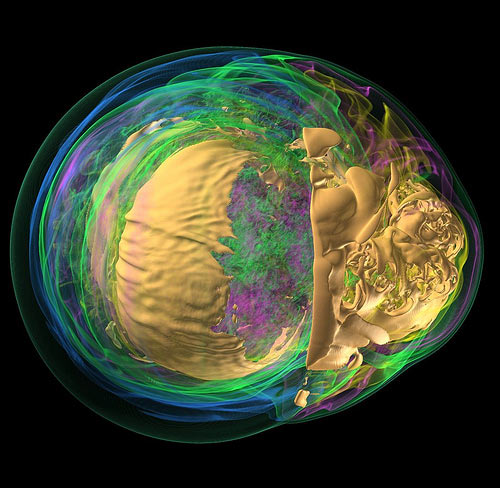Mock Supernova Created by Supercomputer

A new viewof supernovas ? the spectacular explosions of dying stars ? has come not from atelescope, but from a powerful supercomputer simulation.
Thesimulated supernova, revealed in cut-away layers in the rendering, grew out ofan effort to develop faster ways to build high-fidelity computer models ofcomplex phenomena in the real world.
Performinga single run of a current model of the explosion of a star on a home computerwould be next to impossible ? it would take more than three years just todownload the data. So scientists instead use supercomputers,which can handle processing quadrillions of data points at a time.
"Onthe scale that we?re working, creating a movie would take a very long time onyour laptop ? just rotating the image one degree could take days," saidMark Hereld, who leads the visualization and analysis efforts at the U.S.Department of Energy's Argonne National Laboratory.
The modelsrun on these computers can generate visualizations of everything from supernovasto protein structures.But even with the speed supercomputersprovide, the complex models are quickly overwhelming current computingcapabilities.
Scientistsat Argonne are exploring other ways to speed up the process, using a techniquecalled software-based parallel volume rendering.
Volumerendering is a technique that can be used to make sense of the billions of tinypoints of data collected from an X-ray, MRI, or a researcher?s simulation. Theeffort could particularly help in manipulating images and creating movies fromthem.
Get the Space.com Newsletter
Breaking space news, the latest updates on rocket launches, skywatching events and more!
Thetechniques the researchers are working on use parallel computing ? processingdata in multiple computing cores (160,000 cores for Argonne's computer). Thedata is then usually sent to graphics processors (GPUs) to make images, butbecause most GPUs are developed in the video gaming industry, they're notalways well suited for scientific tasks. It also takes a lot of computing powerto move all that data over.
Argonne researchers wanted to know if theycould improve performance by skipping the transfer to the GPUs and insteadperforming the visualizations right there on the supercomputer. They tested thetechnique on a set of astrophysics data and found that they could indeedincrease the efficiency of the operation.
"Wewere able to scale up to large problem sizes of over 80 billion voxels per timestep and generated images up to 16 megapixels," said Tom Peterka, apostdoctoral researcher at Argonne.
This newvisualization method could enhance research in a wide variety of disciplines,Hereld said.
"Inastrophysics, studying how starsburn and explode pulls together all kinds of physics: hydrodynamics,gravitational physics, nuclear chemistry and energy transport," he said."Other models study the migration of dangerous pollutants through complexstructures in the soil, to see where they?re likely to end up; or combustion incars and manufacturing plants?where fuel is consumed and whether it'sefficient."
"Thosekinds of problems often lead to questions that are very complicated to posemathematically," Hereld said. "But when you can simply watch a starexplode through visualization of the simulation, you can gain insight that?snot available any other way."
Argonne's work in advanced computing issupported by the Department of Energy?s Office of Advanced Scientific ComputingResearch (ASCR).
- Video ? Supernova Destroyer/Creator
- Video ? Supernovas: Beacons in the Night
- What Is A Supernova?
Join our Space Forums to keep talking space on the latest missions, night sky and more! And if you have a news tip, correction or comment, let us know at: community@space.com.

Space.com is the premier source of space exploration, innovation and astronomy news, chronicling (and celebrating) humanity's ongoing expansion across the final frontier. Originally founded in 1999, Space.com is, and always has been, the passion of writers and editors who are space fans and also trained journalists. Our current news team consists of Editor-in-Chief Tariq Malik; Editor Hanneke Weitering, Senior Space Writer Mike Wall; Senior Writer Meghan Bartels; Senior Writer Chelsea Gohd, Senior Writer Tereza Pultarova and Staff Writer Alexander Cox, focusing on e-commerce. Senior Producer Steve Spaleta oversees our space videos, with Diana Whitcroft as our Social Media Editor.









